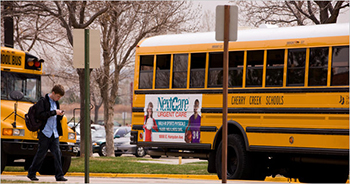Philadelphia Schools Move Toward Advertising in Schools
 PHILADELPHIA — The Philadelphia school system is currently facing a budget shortfall of roughly $304 million. In October, this intimidating figure prompted two city council members to propose selling advertising space on the district’s buses and facilities as a way to help defray mounting operational costs.
PHILADELPHIA — The Philadelphia school system is currently facing a budget shortfall of roughly $304 million. In October, this intimidating figure prompted two city council members to propose selling advertising space on the district’s buses and facilities as a way to help defray mounting operational costs.
Council President Darrell Clarke and fellow member Blondell Reynolds-Brown introduced the bill that would allow district schools to raise money through ad sales. On Dec. 3, the City Council largely sided with Clarke and Reynolds-Brown, and gave the bill their preliminary approval. However, Councilman Dennis O’Brien opposed the bill, preferring to keep school funding issues in the realm of state lawmakers.
Though the bill has drawn opposition from education groups and parents who warn against marketing directly to children, Reynolds-Brown described the plan as supplying much-needed revenue. “Imagine, like in California, a West Philadelphia football field paid for by Nike,” she said.
The renewed ad sales plan would allow both illuminated and digital advertisement on school property, while still barring ads for tobacco and alcohol within 1,000 feet of schools. According to Brown, advertisements for unhealthy foods may also be restricted. The bill called for a planning commission to deliver implementation regulations within 45 days of the effective date of the ordinance.
Though the council has approved the bill, the district’s School Reform Commission will ultimately decide its fate. Fran Burns, the district’s chief operating officer, was quoted as saying that, although the bill had advanced in the council, that move “does not guarantee execution.” Burns added in a statement, “While we remain impartial to how revenue is generated, we acknowledge this idea as a way to generate income from nontax revenue.” If the commission does green light the bill, it could also apply stricter advertising standards.
Both Clarke and Reynolds-Brown had individually pushed similar legislation in the past. “Last spring, I introduced a measure to advertise on school buses, and we ran into some hurdles, so we’ve been in conversation with the school district,” said Reynolds-Brown in October. “Parallel with that, Council President Clarke had an interest in putting advertisements on school buildings, so we’ve collapsed the two into one.” In 2004, officials also floated a plan to auction off naming rights to a newly built district school, but the plan never came to fruition.
Philadelphia is not the first school district to consider selling ad space, a method that has proven financially successful in several other communities across the country. After Texas lawmakers trimmed more than $5 billion in education funding and grants from their 2012 budget, multiple districts began the practice, offering ad space in newsletters, school buses and sports stadiums.
In 2012 New Jersey schools also turned to ad sales after budget cuts put a squeeze on their operations, while schools in Colorado even made headlines for putting ads at the bottom of student report cards. Meanwhile, Idaho, Minnesota and several other states have also supplemented their budgets with various ad sales. During the Dec. 3 meeting, Brown also referenced New York City schools, which have added roughly $6 million to their annual operating budgets by placing ads on the sides of school buses.
